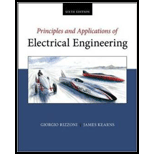
Concept explainers
The current through a 0.8-H inductor is given by
The expression for the voltage across the inductor.
Answer to Problem 4.1HP
The expression for the voltage across the inductor is
Explanation of Solution
Calculation:
The expression for the voltage across the inductor is given by,
Substitute
Conclusion:
Therefore, the expression for the voltage across the inductor is
Want to see more full solutions like this?
Chapter 4 Solutions
Principles and Applications of Electrical Engineering
- Sketch the phasor diagram of the rms voltage across the inductor vL and rms source VS in the circuit shown below. how would use of an osciloscope help solve this problem?arrow_forwardThe attached waveform VS displayed on the oscilloscope approximate the following quantities.1. The peak voltage.2. The peak-to-peak voltage.3. The frequency of the waveform.4. The difference in time that corresponds to a 72 degree phase shift for this waveform. How would use of an osciloscope aid in solving this problem?arrow_forwardVs -J XcR Wo R²=3JRX < -Xc * Xc = ± Wc How do I make this Vs equation Look? ✓ = 3 + 1 (RWC- RWC) Vo 3+arrow_forward
- Draw the complete circular stator winding for a three phase delta connected AC generator consisting of 4 poles and 24 slots using a parallel connection. Your submission must consist of two drawings as follows: One drawing must show the winding arrangement of the phasegroups in the slots of the stator highlighting the start and finish of each phasegroup The other drawing must show only the end connections of each phase group for a parallel connection of the phasegroups and a delta connection of the phases The use of AutoCad or any other software is encouraged.arrow_forwardFor the oscillator resonance circuit shown in Fig. (5), derive the oscillation frequency, Feedback and open-loop gains. R1 C1 C2 ww R2 HH Fig.(5)arrow_forwardFor the oscillator resonance circuit shown in Fig. (5), derive the oscillation frequency, Feedback and open-loop gains. Vo L C I C ли ER Vsarrow_forward
- not use aiarrow_forwardFor the Fig. name, derive and determine all gains, frequency and draw the output waveform. Choose Q-15, and Q=6. Choose C₁-20 µF, C₂-5 µF, L=25mH. R₂ 12 HHarrow_forward1. (30pts) The input to a system is a DC component, a message, m(t), and a carrier, c(t). The output of the system is the square of the sum of the inputs. Determine if it is possible to retrieve DSB-SC modulated waveform. Show your work.arrow_forward
 Delmar's Standard Textbook Of ElectricityElectrical EngineeringISBN:9781337900348Author:Stephen L. HermanPublisher:Cengage Learning
Delmar's Standard Textbook Of ElectricityElectrical EngineeringISBN:9781337900348Author:Stephen L. HermanPublisher:Cengage Learning
